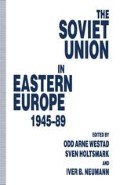Abstract
One may easily draw up general models of how the Soviet Union imposed its political system on neighbouring countries on its Western borders and beyond in the aftermath of the Second World War. However, the challenges and threats directed against Soviet hegemony in East-Central Europe — from the Tito—Stalin conflict to the effects of de-Stalinization — followed a wide variety of patterns.
Access this chapter
Tax calculation will be finalised at checkout
Purchases are for personal use only
Preview
Unable to display preview. Download preview PDF.
Notes
According to Vernon Aspaturian, the process of assimilation of non-Russian ethnic groups in the Soviet Union is made up of three distinct phases, three levels of depth: Sovietization, that is the imposing and acceptance of the Soviet institutions, a process of integration into the Communist system; Russianization, which concerns exclusively the linguistic aspect, in other words the imposing and assimilation of Russian as an official language; and Russification, a complex process, more individual than collective, through which the individuals who belong to other ethnic groups than the Russians are objectively and psychologically transformed into Russians, without necessarily implying that they lose their national identity and consciousness. It is clear that the ethnic, linguistic and cultural assimilation in the USSR was based, first of all, on Russification and Russianization — practices which were taken over by the Soviet regime from the tsarists — and only afterwards on Sovietization, as a ‘recent’ epiphenomenon of the first two phenomena. See Vernon V. Aspaturian, ‘The Non-Russian Nationalities’ in Allan Kassof (ed.), Prospect for Soviet Society (New York: Praeger, 1968) pp, 159–60.
George Cioranescu, Bessarabia. Disputed Land Between East and West, (Murich: Editura Ion Dumitru, 1985) pp. 207–14.
Nicholas Dima, From Moldavia to Moldova. The Soviet-Romanian Dispute (Boulder: East European Monographs; New York: Columbia University Press, 1991) p. 114.
Vlad Georgescu, Politico si istorie. Cazul comunistilor romani 1944–1977 (Politics and History. The Case of the Romanian Communists 1944–1977) (Bucharest: Editura Humanitas, 1991) pp. 28–9 and 34.
Joseph Rothschild, Return to Diversity. A Political History of East Central Europe Since World War II (New York, Oxford: Oxford University Press, 1989) p. 161.
Sergiu Verona, Military Occupation and Diplomacy. Soviet Troops in Romania1944–1958, (Durham and London: Duke University Press, 1992) pp. 82–6, 132–5;
for another viewpoint see Silviu Brucan, Generatia irosita. Memorii (The Lost Generation. Memoirs) (Bucharest: Editurile Universul & Calistrat Hogas, 1992) pp. 75–6.
New York Times, 25 February 1958; Joseph F. Harrington and Bruce J. Courtney, Tweaking the Nose of the Russians: Fifty Years of American– Romanian Relations, 1940–1990 (Boulder: East European Monographs; New York: Columbia University Press, 1991) pp. 194–8.
Karl Marx, Insemnari despre romani (Notes on Romanians) (Bucharest: Editura Academiei, 1964) pp. 105–6.
‘After Gheorghiu Dej’s death we preserved the outward appearance of the same comradely politeness in our relations, but it began to feel artificial. I think Comrade Maurer was to blame for that. Romania wanted to have autonomy for its armed forces. It wanted to be independent from the other Warsaw Pact countries. We realized this for the first time when Romania refused to buy arms from Czechoslovakia in accordance with the pact’s procurement plans. There were other facts reported to me by Marshal Grechko’, Khrushchev Remembers. The Glasnost Tapes, (Toronto, London: Little, Brown, 1990) p. 113.
Jacques Lesourne and Bernard Lecomte, De l’Atlantique à l’Oural. L’après-communisme, (Paris: Editions Robert Laffont, 1990) p. 39.
Editor information
Editors and Affiliations
Copyright information
© 1994 Palgrave Macmillan, a division of Macmillan Publishers Limited
About this chapter
Cite this chapter
Pop, A. (1994). When the Mouse Challenges the Cat: Bessarabia in Post-War Soviet—Romanian Relations. In: Westad, O.A., Holtsmark, S., Neumann, I.B. (eds) The Soviet Union in Eastern Europe, 1945–89. Palgrave Macmillan, London. https://doi.org/10.1007/978-1-349-23234-5_6
Download citation
DOI: https://doi.org/10.1007/978-1-349-23234-5_6
Publisher Name: Palgrave Macmillan, London
Print ISBN: 978-1-349-23236-9
Online ISBN: 978-1-349-23234-5
eBook Packages: Palgrave Political & Intern. Studies CollectionPolitical Science and International Studies (R0)

